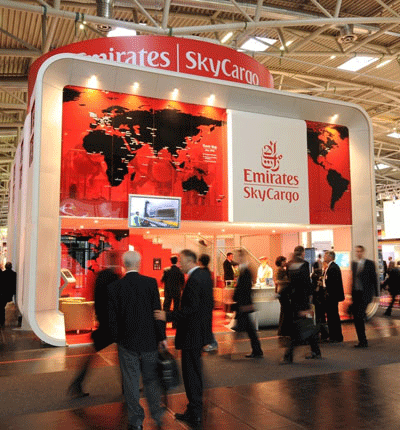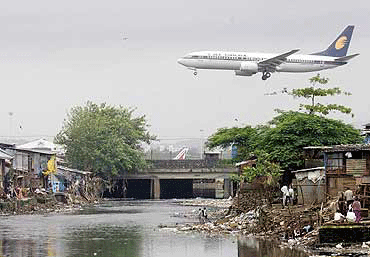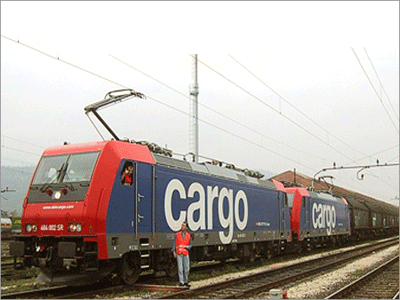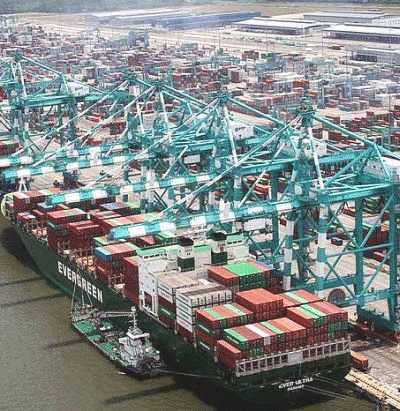Infrastructure Challenges
India
 During
this week as transportation professionals gathered in Mumbai for Air
Cargo India here is an exclusive report outside the cordiality hand
shaking, back slapping world of hospitality ambience that offers the
latest news about facts and figures-driven information about India’s
air, rail and port infrastructure that many consider the number one
issue of doing business there as 2010 begins. During
this week as transportation professionals gathered in Mumbai for Air
Cargo India here is an exclusive report outside the cordiality hand
shaking, back slapping world of hospitality ambience that offers the
latest news about facts and figures-driven information about India’s
air, rail and port infrastructure that many consider the number one
issue of doing business there as 2010 begins.
The Indian government has announced a
series of measures aimed at attracting foreign investment into the Indian
economy and assisting with the restructuring of the nation’s somewhat
decrepit infrastructure architecture.
To this end, the government has provided
mechanisms that allow for private investment in public schemes, and
has advised that the government will participate in the financing of
these, typically to the tune of about 30 percent of the required investment,
with the balance to be generated by the private sector.
For the first time, the government has
included private investment as a key source of infrastructure financing,
as described in India’s 11th Five Year Plan.
 The Indian government invested USD$218
billion in infrastructure during the five-year period of 2002 to 2007.
This represented a spending equivalent of about 3 percent of India’s
GDP. From 2009 to 2012, the government intends to spend about USD$514
billion on infrastructure, and assuming a GDP growth rate of around
9 percent during this period, the government will invest 9 percent of
its GDP in its infrastructure. This will effectively triple its fiscal
spending. That amount, even if spent well, is not enough to satisfy
the nation’s needs. To combat this problem, the government has
identified the private sector as the majority participant in India’s
redevelopment.
The Indian government invested USD$218
billion in infrastructure during the five-year period of 2002 to 2007.
This represented a spending equivalent of about 3 percent of India’s
GDP. From 2009 to 2012, the government intends to spend about USD$514
billion on infrastructure, and assuming a GDP growth rate of around
9 percent during this period, the government will invest 9 percent of
its GDP in its infrastructure. This will effectively triple its fiscal
spending. That amount, even if spent well, is not enough to satisfy
the nation’s needs. To combat this problem, the government has
identified the private sector as the majority participant in India’s
redevelopment.
This is a quite different model from China,
which ensured in most cases that infrastructure projects were state
financed, retaining control of infrastructure ownership, thus limiting
the opportunities for foreign investors. This forced many of them into
long-term joint ventures with unwanted or unnecessary state-owned partners,
while the state later added additional tax and employment burdens to
foreign investors. In China, investors got into infrastructure development
projects because of government.
In India, investors should be getting
into infrastructure projects because the government involvement is being
decreased. It is not necessary to partner with an Indian state-owned
enterprise.
In this way, the Indian government has
finally made the problem of its infrastructure an opportunity for foreign
investors. The scale of the projects is massive.
AIRPORTS
 India
has a total of 454 airports (including grass runways), of which 16 have
international status. Of these, the Airports Authority of India (AAI)
owns and operates 97. The AAI has stated it aims at upgrading all of
these as well as adding new locations to better unify the country within
the next 12 years. This requires infrastructure investment in terminals,
runways and related construction to full operational and passenger capability
at over 500 airports. India
has a total of 454 airports (including grass runways), of which 16 have
international status. Of these, the Airports Authority of India (AAI)
owns and operates 97. The AAI has stated it aims at upgrading all of
these as well as adding new locations to better unify the country within
the next 12 years. This requires infrastructure investment in terminals,
runways and related construction to full operational and passenger capability
at over 500 airports.
The government has stated several times
its intention to attract private investment into this sector, and many
domestic and multinational players have been showing interest in the
projected growth of India’s aviation sector. Much of this is within
airport development and management. Some of these include India’s
private airlines, among them Jet, Sahara, Kingfisher, Deccan, and Spicejet,
who collectively account for about 60 percent of India’s domestic
passenger traffic.
Some, such as Kingfisher, have now started
international flights, while others will follow shortly once regulatory
procedures are completed. India is now poised to meet international
standards in the development and infrastructure of its airports, as
any recent traveler to Delhi, Mumbai or Chennai will testify. The government
is planning modernization of the airports to establish a standard, while
newly developed airports will help release pressure on the existing
airports in the country.
The Delhi and Mumbai airports are in the
process of being upgraded, while Bangalore and Hyderabad will also soon
be upgraded to international airport. They are all earmarked for privatization
once construction work is completed. Several
regional airports are also set for significant upgrading to international
standards, including Amritsar, Gutuahati, Ahmedabad, Goa, Chennai and
Cochin.
According to the AAI, investment of USD$8.5
billion has been planned for the development of Indian airports during
the 11th Five Year Plan. The airports in Mumbai and Delhi have already
been privatized and are now being upgraded at an estimated investment
of USD$4 billion.
The AAI plans to invest an additional
USD$3.07 billion over the next five years. From this, 43 percent will
be for the three metro airports in Kolkata, Chennai and Trivandrum.
The remainder will be invested in upgrading other non-metro airports
and in the modernization of the existing aeronautical facilities, such
as radar and related equipment upgrades. The Ministry of Civil Aviation
has reported the following statistics and figures:
•
Passenger traffic is projected to grow at a CAGR of over 15% in
the next five years; it is estimated that traffic will reach 100
million passengers per annum by 2010
•
Cargo traffic to grow at over 20% per annum; over the next five
years, crossing 3.3 million tons by the end of this year.
•
Major investments planned in new airports and up gradation of existing
airports
•
100% FDI is permissible for existing airports; FIPB approval required
for FDI beyond 74%.
•
100% FDI under automatic route is permissible for Greenfield airports.
•
49% FDI is permissible in domestic airlines under the automatic
route, but not by foreign airline companies.
•
100% equity ownership by non-resident Indians (NRIs) is permitted.
•
AAI Act amended to provide legal framework for airport privatization.
•
100% tax exemption for airport projects for a period of 10 years |
The “open sky”
policy of the government and rapid air traffic growth have resulted
in the entry of several new privately owned airlines and increased frequency/flights
for international airlines; foreign airlines currently have the lion’s
share of passenger traffic into and out of India as the approvals procedures
for obtaining a license to operate in India as a foreign airline is
just two years, as opposed to five for Indian domestic carriers operating
international routes.
 RAIL RAIL
Investment is needed to improve track,
rolling stock and delivery times. At present passenger trains manage
an average of 50 kph, while freight just 22 kph. Indian Railways has
long been regarded as the backbone of the socioeconomic growth of India.
The country has the world’s fourth largest rail network and the
second largest in Asia after China. Indian Railways has recently attracted
immense global media and corporate attention due to its turnaround to
profitability, and has been consistently recording buoyant growth rates
over the last few years as India’s population continues to increase.
According to India Railways, the government
estimated the cash surplus for 2007-08 before dividend and net revenue
at USD $6.17 billion and USD $4.53 billion respectively. This places
Indian Railways in a better position than many Fortune 500 companies.
India Railways stated that they earmarked
about USD$7.91 billion in 2008-09 for an ambitious plan. The plan includes
a total budgetary support of USd$1.66 billion that includes USd$163.33
million from the Central Road Fund. This plan has been slated to turn
sizable profits running into the billions of dollars for the years 2010
and beyond.
Indian Railways has identified the following
initiatives to help transform the viability of Indian rail into a commercially
acceptable operational model:
•
Increases in income through advertising on all Rajdhani (luxury
express coaches), with the cost of advertising being around USD$1.26
million per train.
•
Introduction of new generation trains that would be fuel-efficient,
recyclable and have low-emission to generate certified emission
reduction credits.
•
Construction of a dedicated freight corridor, with an investment
of USD$81.92 million for 2008-09 and USD$614.40 million slated for
2009-10.
•
Renewal of 44.5 million pre-stressed concrete (PSC) sleepers set
for open line work.
•
Technological upgrades and modernization for higher operating efficiency.
•
Development of PPP in new routes, railway stations, logistics parks,
cargo aggregation and warehouses.
•
Development of 100 budget hotels with private participation in the
vicinity of railway stations.
•
Installation of Wi-Fi to provide wireless access at 500 stations
•
Introduction of marketing rights for advertising on railway tickets
and reservation charts.
•
Establishment of integrated logistic parks on unused lands.
•
Development of agri-retail hubs, cold storage houses, multi-purpose
warehouses on surplus land with the railways.
•
Training of railway managers to meet future challenges, Indian Railways
is planning to set an international management institute in New
Delhi.
•
Renewal of over 2941 kilometers of rail, which will require 3.39
million tons of rail steel, and over 2,382 kilometers of pre-stressed
concrete sleeper renewal.
•
Implementation of dynamic pricing policy, tariff rationalization,
non-peak season incremental freight discount scheme, empty flow
direction freight.
•
Discount schemes, loyalty discount schemes and long-term freight
discount schemes among others to boost capacity utilization levels. |
Meanwhile, according to the Ministry
of Railways, increases of freight and cargo in both domestic and international
routes have placed considerable stress on capacity on the two main Delhi-Mumbai
and Delhi-Kolkata lines. The government has decided to build dedicated
freight corridors in the Western and Eastern high-density routes to
cater for this deficit. The investment is expected to be about (USD$4.9
billion). Surveys and project reports are in progress and work is expected
to commence within the coming year.
Previously, containerization was operated under
a state monopoly, CONCOR. Facing the increasing containerization of
cargo and freight, this sector has now been liberalized and is open
to competition. Private sector entities may now either partner with
or compete with CONCOR. The government has stated that 14 applicants
have currently submitted applications seeking permission for container
train operation, all of which have been approved.
PORTS
There is a notorious delay in turnaround
times at Indian Ports, in Mumbai it typically takes about three days
to turn a container ship around, in Shanghai it takes eight hours. Massive
investment is required to combat problems with inadequate berths, road
links, and related infrastructure constraints.
 The major Ports highlighted for redevelopment
are namely Kandla, Mumbai, Mormugao, New Mangalore on the east coast,
Cochin and Tuticorn to the South, and Chennai, Ennore, Vizag, Paradip
and Kolkata on the east coast.
The major Ports highlighted for redevelopment
are namely Kandla, Mumbai, Mormugao, New Mangalore on the east coast,
Cochin and Tuticorn to the South, and Chennai, Ennore, Vizag, Paradip
and Kolkata on the east coast.
With 12 major ports and 187 minor ports, the
7,517 kilometer-long Indian coastline plays a key role in maritime transport
amongst international trade capabilities.
The Indian government reported that traffic
handled at India’s major ports during April 2008 to January 2009
reached 436,686 units. The ports situation in India therefore offers
tremendous scope for the development of international maritime transport
both for passenger and cargo handling.
According to the Department of Shipping, the
government of India has targeted an increase in the cargo handling capacity
of major ports by 200 percent to reach 1.5 billion metric tons by the
year 2012.
They aim to achieve this through an investment
of USD$25 billion through public-private partnerships. An independent
credit rating report focusing on Indian ports and maritime transport
estimated that port capacity will grow by 160 percent over the 2011–12
period. Cargo handling at the major ports is projected to grow at 7.7
percent annually to 2011-12, while cargo traffic is estimated to reach
877 million tons by 2011-12. Containerized cargo is expected to grow
at 15.5 percent over seven years. The new foreign trade policy sees
India’s share of global exports doubling in the next five years
to USD$150 billion. A large portion of newly generated foreign trade
is expected to be via shipping, taking an estimated 95 percent by volume
and 70 percent by value of India’s total trade.
The government has undertaken the expansion
and modernization of ports on a priority basis as part of its initiatives
in the up gradation of India’s infrastructure achieving the targeted
growth rate. According to the Ministry of Shipping, this includes numerous
plans:
•
Formulation of a national maritime development policy to facilitate
private investment, improve service quality and promote competitiveness.
USD$11.33 billion has been allocated for the same.
•
An investment of more than USD$9.07 billion to be made by 2015 for
111 shipping sector projects.
•
In 2008–09, the Ministry of Shipping launched 10 major expansion
projects at an estimated investment of USD$1.06 billion, 60% of
which was allocated for the Chennai mega container terminal.
•
Permission for 100% foreign direct investment for port development
projects under the automatic route.
•
100% income tax exemption is provided for a period of 10 years for
port developmental projects.
•
The opening up of all the areas of port operation for private sector
participation.
•
Increase in the rail connectivity of ports with the domestic market.
•
The experience of operating berths through PPPs at some of the major
ports in India has thus far been successful. It has been decided
to expand the program and allocate new berths to be constructed
through PPPs. A model concession agreement is being formulated for
this purpose.
•
The government has also decided to empower and enable the 12 major
ports to attain world-class standards; to this end, each port is
preparing a prospective plan for 20 years and an action plan for
seven years.
•
A high level committee has finalized the plan for improving rail-road
connectivity of major ports; the plan is to be implemented within
a period of three years and further changes in customs procedures
are being carried out with a view to reducing the dwell time and
transaction costs; the government has also delegated powers to the
respective port trusts for facilitating speedier decision-making
and implementation, at the same time, several measures to simplify
and streamline procedure related to security and customs are been
initiated.
•
The National Maritime Development Program is expected to bring a
total investment of over USD$120 million into port infrastructure;
improvements in the scale and quality of Indian port infrastructure
are recognized as significantly improving India’s competitive
advantage in an increasingly globalized world. |
POWER
India requires an additional 100,000 megawatts
of power by 2012. The country currently has a peak deficit of 18 percent
and an overall deficit of 9 percent. While India possesses the fifth
largest electricity generation capacity in the world, it has low per
capita consumption at just 606 units, less than half of China’s
consumption per head.
While concerns exist over Chinese- managed
projects close to India’s border areas, opportunities exist for
politically neutral energy providers to service the India market.
According to the Ministry of Power, the
total installed capacity in India is calculated to be 145,554.97 megawatts.
They also state that:
•
Generation capacity of 122 GW; 590 billion units produced (1 unit
= 1kwh) CAGR of 4.6% over the last four years.
•
India has the fifth largest electricity generation capacity in the
world with low per capita consumption at 606 units.
•
Transmission and distribution network of 5.7 million circuit kilometers.
•
Coal-fired plants constitute 57% of the installed generation capacity,
followed by 25% from hydroelectric power, 10% gas-based, 3% from
nuclear energy and 5% from renewable sources. |
The State Electricity Regulatory
Commission has said that India possesses a vast opportunity to grow
in the field of power generation, transmission, and distribution. The
target of over 150,000 megawatts of hydroelectric power germination
is yet to be achieved. However, by 2012, India requires an additional
100,000 megawatts of generation capacity. A huge capital investment
is required to meet this target. This has resulted in numerous power
generation, transmission, and distribution multinationals to establish
operations in the country under the PPP program. The power sector is
still experiencing a large demand-supply gap, and this has called for
an effective consideration of some of strategic initiatives. There
are strong opportunities in transmission network ventures – an
additional 60,000 circuit kilometers of transmission network is expected
by 2012 with a total investment opportunity of about USD$200 billion.
According to the Ministry of Power, the
implementation of key reforms is likely to foster growth in all segments
as follows:
•
Coal based plants at pithead or coastal locations (imported coal).
•
Natural gas/CNG based turbines at load centers or near gas terminals.
•
Hydroelectric power potential of 150,000 MW is untapped as assessed
by the government of India.
•
Renovation, modernization, upgrading and life extension of old thermal
and hydroelectric power plants. |
Opportunities exist in:
•
Allowing foreign equity participation up to 100% in the power sector
under the automatic route.
•
Encouraging the private sector to set up coal, gas or liquid-based
thermal projects, hydroelectric projects and wind or solar projects
of any size.
•
Constitution of independent state electricity regulatory commissions.
•
Deregulation of the ancillary sectors such as coal.
•
Introduction of the Electricity Act and the notification of the
national electricity and tariff policies.
•
Provision of income tax holiday for a block of 10 years in the first
15 years of operation and waiver of capital goods’ import
duties on mega power projects (above 1,000 MW generation capacity) |
Unbundling of the state
electricity boards (SEBs) into generation, transmission, and distribution
companies for better transparency and accountability
Initiatives the government has introduced
to facilitate foreign investment in the sector under the automatic route:
•
Unbundling of vertically integrated Ses.
•
“Open access” to transmission and distribution network.
•
Distribution circles to be privatized.
•
Tariff reforms by regulatory authorities. |
Gordon Feller
|



